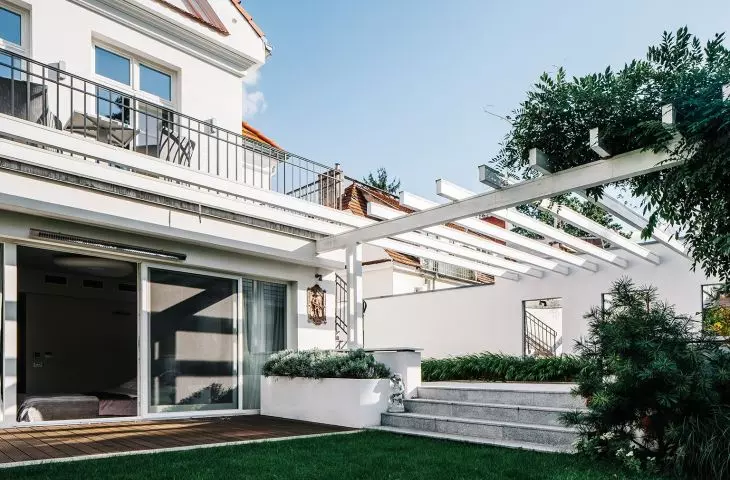The villa in Old Bielany in Warsaw is a building with a long history. Built in the 1930s as part of the Zdobycz Robotnicza estate, it was a house that housed as many as four families. Years later, it was time for a change and its new owners approached architect Jagna Bielowicka with a request for a complete reconstruction. The 200-square-meter house was expanded, creating a property of almost 510 square meters with a garden and a hidden pool. And all this under the watchful eye of a preservationist.
Part of the facade had to be faithfully reproduced
Photo: Ignacy Matuszewski © Jagna Bielowicka
Dobrawa Bies: The Old Bielany House is a 1930s villa that underwent a metamorphosis. Despite the expansion and the introduction of modern solutions, the building has retained its pre-war style from the outside. How do you work on such challenges? What did you start the project with?
Jagna Bielowicka: The building is part of the Zdobycz Robotnicza estate and is located in a conservation zone, so the front facades had to be faithfully restored. However, it was possible to expand the house on the garden side. The new part of the house was designed in a modern way, with large glazing, so as to contrast with the old - I consider this approach to object preservation to give the best results and to be the fairest to both the past and the future of the object. I begin my work on a historic building by seeking information regarding the original design of the building and its later transformations. Such materials are helpful when talking to a preservationist if, for example, the changes being made would restore the original appearance.
Lowering the level of the garden made it possible to create an exit from the bedroom straight onto the lawn
Photo: Ignacy Matuszewski © Jagna Bielowicka
The biggest challenge is to reconcile conservation guidelines with contemporary functional requirements. Construction on Płatnicza Street was low-cost construction, the houses were small, each mezzanine floor was at a different height. The building whose design we are discussing at one time housed four families, there were two separate entrances and the staircase itself inside. Nowadays, open spaces are sought. The challenge was to get rid of the mezzanine floors in the house, opening up the space while maintaining the height of the existing windows. An interesting solution I used in this house was to lower the garden level by about 60 centimeters. This allowed me to make an exit from the bedroom to the garden and preserve the flat surface of the lawn, without slopes or stairs.
It was possible to expand the house from the garden side
Photo: Ignacy Matuszewski © Jagna Bielowiecka
Dobrawa: In addition to the architecture and surroundings, you are also responsible for the interior design. What changes were made, and what remained from the original design?
Jagna Bielowiecka: Since I did both the architectural design and the interior design, changes at the finishing stage were not necessary. When I draw an architectural design, I think about the interiors, and often it is from thinking about the interiors that the architectural design begins. I ask the client what rooms in the house are the most important for him, and from them I start laying out the space.
The garden also hides a swimming pool
Photo: Ignacy Matuszewski © Jagna Bielowicka
Dobrawa: What requirements did the clients set for you?
Jagna Bielowicka: The clients presented me with their dream program for the house, and specified what areas would meet their expectations. In addition, they wanted a sense of intimacy both in the house and in the garden. The house had to be friendly for young children, but also should "grow" with the family and be prepared for later changes.
bright interiors of the villa
Photo: Ignacy Matuszewski © Jagna Bielowicka
Dobrawa: How to combine modernity with historical elements to maintain design consistency?
Jagna Bielowicka: Combining historical and modern elements is a game of contrast, the contrast can be at the level of color, texture, material or form. The more ornate the historical detail, the better the modern minimalism will look next to it.
In the house on Płatnicza Street, the modern facade elements are wide windows. However, to be consistent with the old part, the woodwork of these windows is white and wooden - just like the historic windows. I also decided that the house is too small and intimate to introduce some other facade material like stone for the new extension.
The garden was created in collaboration with greenery architect Magdalena Kazulo-Kleyff
Photo: Ignacy Matuszewski © Jagna Bielowicka
To break the historic look of the house, I wanted a modern garden, with modern elements of small architecture. What builds cohesion between the building and the garden is the white color appearing on the pergola, finishing elements, furniture or pots. For the design of the garden, I worked with green architect Magdalena Kazulo-Kleyff.
Dobrawa: Thank you for the interview.

























































